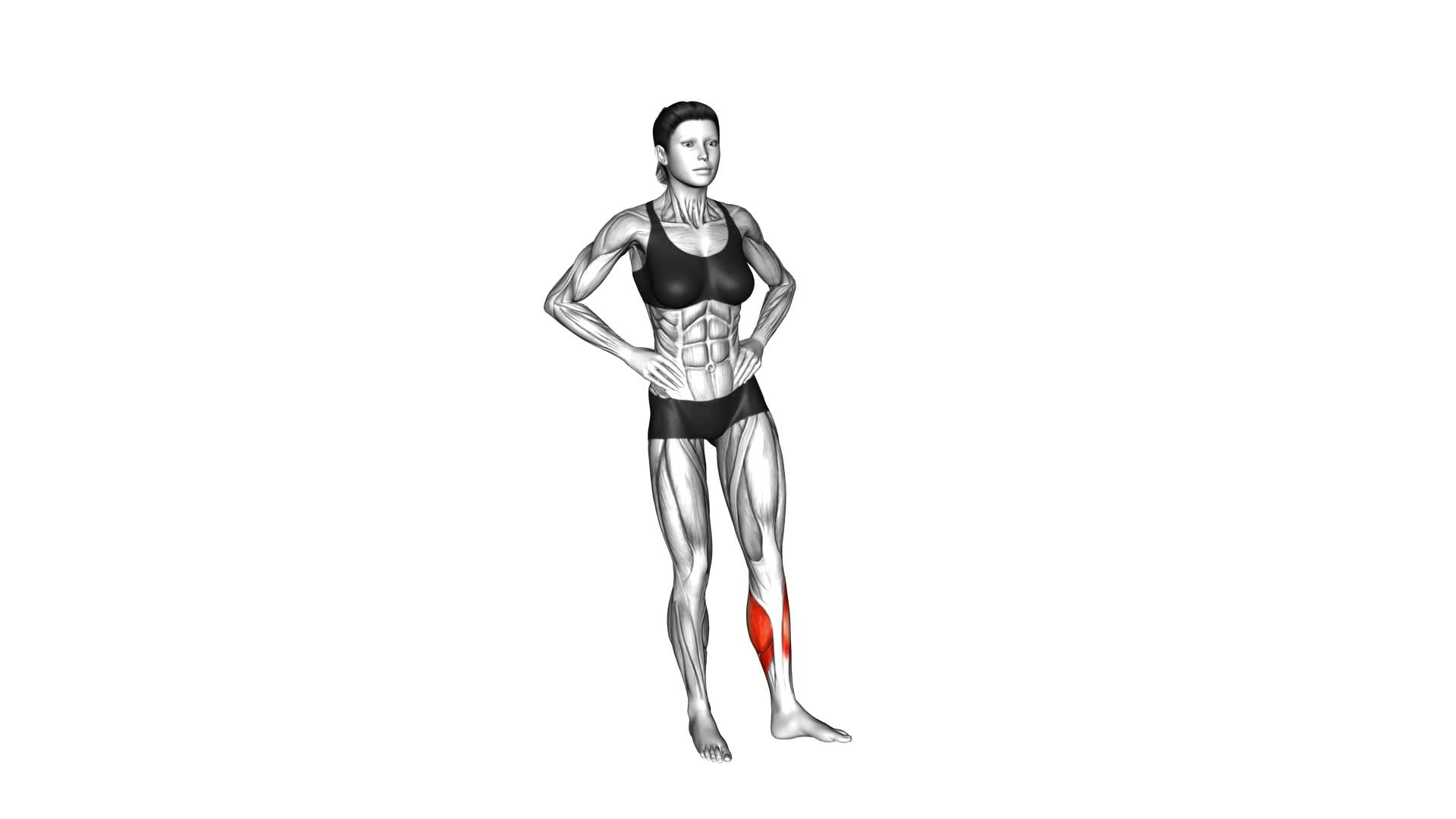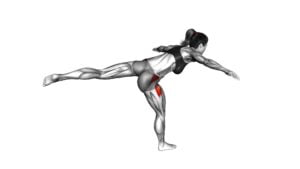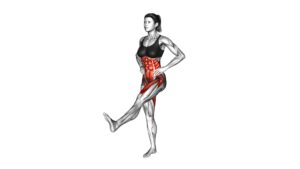Standing Balance Ankle Rotation (female) – Video Exercise Guide & Tips

Are you looking to improve your balance and strengthen your ankles? Look no further!
Watch This Exercise Video
In this video exercise guide, we'll show you how to perform standing balance ankle rotations.
This exercise is perfect for females who want to target their ankle stability and prevent injuries.
With the help of our step-by-step instructions and helpful tips, you'll be on your way to better balance and stronger ankles in no time.
Let's get started!
Key Takeaways
- Standing balance ankle rotation improves ankle strength, stability, and mobility.
- This exercise reduces the risk of sprains or strains and enhances overall body stability.
- It improves coordination and balance while providing enhanced movement and balance.
- The exercise can be modified and progressed by using resistance bands or ankle weights for added challenge.
Benefits of Standing Balance Ankle Rotation
The benefits of performing the Standing Balance Ankle Rotation exercise include improved ankle strength and stability. This exercise focuses on ankle mobility, which is crucial for maintaining stability and coordination in various activities. By regularly engaging in this exercise, you can enhance the range of motion in your ankles, allowing for better movement and balance.
Ankle mobility plays a vital role in preventing injuries, especially in sports that require quick changes in direction or jumping. Strong ankles can help absorb shock and reduce the risk of sprains or strains. Moreover, improved ankle stability can enhance overall body stability, as the ankles act as a foundation for the entire body.
Incorporating the Standing Balance Ankle Rotation into your fitness routine can also improve your coordination and balance. This exercise challenges your body's ability to maintain stability while performing controlled movements. As a result, your proprioception, or the awareness of your body in space, is enhanced. This can be particularly beneficial for older adults or individuals recovering from injuries, as it can improve their confidence and reduce the risk of falls.
Equipment Needed for the Exercise
To perform the Standing Balance Ankle Rotation exercise, you'll need a stable surface and a chair or wall for support. This equipment is essential for maintaining your balance and stability during the exercise.
Ankle strengthening and balance exercises are crucial for improving stability, preventing injuries, and enhancing overall lower body strength.
Firstly, you'll need a stable surface to stand on. This can be a flat floor or a balance board specifically designed for exercises. The surface should be firm and provide enough support to prevent any wobbling or instability. It's important to choose a surface that suits your fitness level and allows you to maintain proper form throughout the exercise.
Additionally, having a chair or wall for support is vital. This will help you maintain your balance and provide stability as you perform the ankle rotations. You can use a sturdy chair, placing your hand lightly on the backrest for support. Alternatively, you can lean against a wall, ensuring that it's secure and can support your weight.
Proper Form and Technique
Maintain proper form and technique during the Standing Balance Ankle Rotation exercise by focusing on your balance and stability. To ensure you're performing the exercise correctly, it's important to be aware of common mistakes and follow helpful progression tips.
One common mistake to avoid is leaning too far forward or backward. This can throw off your balance and put unnecessary strain on your ankles. Instead, keep your body centered and aligned, maintaining a neutral spine throughout the exercise.
Another common mistake is rushing through the rotations. It's important to perform the movement slowly and controlled, allowing your ankles to fully rotate in each direction. This will help improve your balance and stability over time.
To progress in this exercise, you can increase the duration of the rotations. Start with small movements and gradually increase the range of motion as you become more comfortable and confident. Additionally, you can add resistance by using a resistance band or ankle weights to challenge your muscles further.
Remember to always listen to your body and stop if you feel any pain or discomfort. By maintaining proper form, being aware of common mistakes, and following progression tips, you can maximize the benefits of the Standing Balance Ankle Rotation exercise and improve your balance and stability.
Variations and Modifications
Now let's talk about the variations and modifications you can make to the Standing Balance Ankle Rotation exercise.
It's important to keep safety precautions in mind when modifying the exercise to suit your needs.
Different variations can offer unique benefits, so it's worth exploring them to find what works best for you.
However, be aware of common modification mistakes to ensure you're still maintaining proper form and technique.
Safety Precautions for Modifications
When modifying the Standing Balance Ankle Rotation exercise, it's important to ensure your safety by following these precautions.
Firstly, always prioritize injury prevention by listening to your body's limits and not pushing yourself too hard.
It's crucial to start with a proper warm-up to prepare your muscles and joints for the exercise. This can include dynamic stretches, such as leg swings, and gentle movements that increase blood flow to the ankles and feet.
Additionally, make sure you have a stable surface to perform the exercise on, such as a yoga mat or a padded floor. Avoid performing the exercise on an unstable or slippery surface to prevent falls or ankle sprains.
Lastly, if you have any existing ankle or balance issues, consult with a healthcare professional before attempting this exercise modification.
Benefits of Different Variations
Choose the variation of the Standing Balance Ankle Rotation exercise that best suits your fitness level and goals.
Regular practice of this exercise offers several benefits.
Firstly, it helps improve your overall balance and stability by targeting the muscles in your ankles, calves, and lower legs. By strengthening these muscles, you can prevent injuries and enhance your performance in activities that require stability, such as running or sports.
Secondly, the ankle rotation movement engages the muscles in your feet and toes, increasing their flexibility and mobility. This can be particularly beneficial for individuals who spend long hours on their feet or suffer from foot-related issues.
Lastly, incorporating different variations of the exercise can add variety to your workout routine, keeping you engaged and motivated.
Common Modification Mistakes
To avoid common modification mistakes in the Standing Balance Ankle Rotation exercise, focus on correct form and alignment. Proper technique is essential to reap the benefits of this exercise and prevent injuries.
One common modification error isn't maintaining a stable core throughout the movement. Your core muscles play a crucial role in stabilizing your body and maintaining balance.
Another modification mistake is failing to engage the glutes and hip muscles. These muscles help support and stabilize the ankle joint during the rotation.
Additionally, be mindful of not leaning too far forward or backward during the exercise, as this can strain the ankle and compromise your stability.
Common Mistakes to Avoid
To avoid common mistakes while performing the standing balance ankle rotation exercise, focus on maintaining a stable stance and engaging your core. One common mistake is losing balance during the rotation. To improve, make sure to distribute your weight evenly on both feet and keep your gaze fixed on a focal point in front of you.
Another mistake is rushing through the exercise. Take your time and move slowly and deliberately, focusing on controlled movements. Additionally, avoid leaning to one side or forward/backward while rotating your ankle. Instead, keep your body upright and centered.
It's also important to avoid tensing your shoulders or holding your breath. Relax your upper body and breathe deeply throughout the exercise.
Lastly, be mindful of the range of motion in your ankle. Start with small rotations and gradually increase as you become more comfortable and stable.
Tips for Progression and Safety
To progress safely in the standing balance ankle rotation exercise, focus on gradually increasing the range of motion in your ankle while maintaining stability and engaging your core. Here are three tips to help you with progression techniques and injury prevention:
- Start with small rotations: Begin by rotating your ankle in small circles, gradually increasing the size of the circles as you feel more comfortable and stable. This will help improve your ankle mobility without putting too much strain on the joint.
- Use a stable surface: When performing the standing balance ankle rotation exercise, make sure you're standing on a stable surface, such as a yoga mat or a firm floor. This will provide a solid base of support and reduce the risk of any slips or falls.
- Listen to your body: Pay attention to any discomfort or pain during the exercise. If you experience any sharp or intense pain, stop immediately and consult a healthcare professional. It's important to progress at a pace that's suitable for your individual fitness level and to always prioritize safety.
Frequently Asked Questions
How Long Should I Hold Each Rotation During the Standing Balance Ankle Rotation Exercise?
When doing the standing balance ankle rotation exercise, it's important to know how long to hold each rotation. The duration can vary depending on your fitness level and goals.
Generally, holding each rotation for 10-15 seconds is a good starting point. This allows your ankle muscles to engage and improve their strength and stability.
The benefits of this exercise include improved balance, ankle mobility, and injury prevention.
Remember to consult with a professional if you have any concerns or specific goals.
Can Men Also Perform the Standing Balance Ankle Rotation Exercise?
Yes, men can also perform the standing balance ankle rotation exercise. It's a great way to improve ankle strength and stability.
There are variations of the exercise that can be tailored to different fitness levels. By incorporating this exercise into your routine, you can enhance your overall balance and reduce the risk of ankle injuries.
Remember to consult with a fitness professional or trainer for proper form and technique.
Is It Normal to Feel Some Discomfort or Fatigue in the Ankle During This Exercise?
Feeling some discomfort or fatigue in the ankle during this exercise is normal. Your ankle is being challenged and engaged in this movement, so it's expected to feel some strain.
However, if the discomfort becomes excessive or you experience sharp pain, it's important to stop and consult with a healthcare professional.
Remember to listen to your body and modify the exercise if needed to avoid any potential injuries.
Can This Exercise Help Improve Balance in Individuals With Ankle Injuries?
Improving stability after an ankle injury is important. Rehabilitation exercises like the Standing Balance Ankle Rotation can help.
This exercise focuses on ankle strength and mobility, which are essential for balance. By rotating your ankle while standing, you challenge the muscles and ligaments, improving their ability to support you.
With regular practice, this exercise can help individuals with ankle injuries regain their balance and prevent future injuries.
Are There Any Specific Warm-Up Exercises Recommended Before Performing the Standing Balance Ankle Rotation Exercise?
Before performing the standing balance ankle rotation exercise, it's important to do specific warm-up exercises to prepare your body. Warm-ups help increase blood flow, loosen up muscles, and reduce the risk of injury.
Some recommended warm-up exercises include ankle circles, calf stretches, and leg swings. These exercises help improve flexibility and mobility in the ankle joint, allowing for better range of motion during the ankle rotation exercise.
Incorporating a proper warm-up routine can enhance the benefits of the ankle rotation exercise.
Conclusion
In conclusion, incorporating standing balance ankle rotations into your exercise routine can provide numerous benefits for the female population. This exercise helps improve ankle stability, mobility, and overall balance.
It can be performed with minimal equipment and can be modified to suit different fitness levels. By maintaining proper form and avoiding common mistakes, you can progress safely and effectively.
Remember to consult with a healthcare professional before starting any new exercise program.

Author
Years ago, the spark of my life’s passion ignited in my mind the moment I stepped into the local gym for the first time. The inaugural bead of perspiration, the initial endeavor, the very first surge of endorphins, and a sense of pride that washed over me post-workout marked the beginning of my deep-seated interest in strength sports, fitness, and sports nutrition. This very curiosity blossomed rapidly into a profound fascination, propelling me to earn a Master’s degree in Physical Education from the Academy of Physical Education in Krakow, followed by a Sports Manager diploma from the Jagiellonian University. My journey of growth led me to gain more specialized qualifications, such as being a certified personal trainer with a focus on sports dietetics, a lifeguard, and an instructor for wellness and corrective gymnastics. Theoretical knowledge paired seamlessly with practical experience, reinforcing my belief that the transformation of individuals under my guidance was also a reflection of my personal growth. This belief holds true even today. Each day, I strive to push the boundaries and explore new realms. These realms gently elevate me to greater heights. The unique combination of passion for my field and the continuous quest for growth fuels my drive to break new ground.







